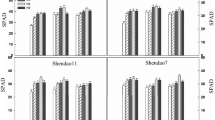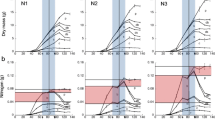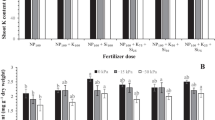Abstract
In order to understand more clearly the dynamics of rice (Oryza sativa L.) yield development in relation to N fertilization, a field experiment was conducted in Laguna, Philippines. The soil, a Maahas clay (Aquic Hapludalf), was flooded, puddled, and then planted with 20-day-old seedlings of IR64 rice. Treatments were six combinations of N fertilizer timing and method: (1) 0 N control; (2) prilled urea broadcast at 15 and 60 days after transplanting (DAT) (BR-LATE); (3) prilled urea injected with a spring auger applicator at 15 DAT and broadcast at 60 DAT (INJ-LATE); (4) prilled urea broadcast and incorporated at 0 DAT and broadcast at 40 DAT (BR-EARLY); (5) urea super granules (USG) manually deep-placed at 3 DAT and prilled urea broadcast at 40 DAT (DP-EARLY); and (6) USG manually deep-placed at 3 DAT (DP). Except for the control, all treatments received a total of 58 kg N ha-1. Yield results were consistent with those of other experiments, namely, DP had the highest yields, the early-split treatments (BR-EARLY and DP-EARLY) were second best, followed by the late-split treatments (BR-LATE and INJ-LATE), with the control having the lowest yield. Sequential harvest results showed that the advantages of DP in terms of dry matter assimilation, tillering, and leaf area index (LAI) were expressed later in the season. For all treatments, midday net CO2 assimilation (Ac) peaked around 48 DAT, approximately panicle initiation. Grain yield was highly correlated with midday Ac at panicle initiation and flowering but not at other growth periods. Rates of midday Ac and night respiration depended strongly on shoot N content. We conclude that N application method and timing should be designed to give high shoot N content at panicle initiation and flowering, and that DP satisfied this requirement best among the treatments tested.
Similar content being viewed by others
References
Akita A 1989 Physiological aspects for improving yield potential in tropical rice cultivation. In Progress in Irrigated gated Rice Research. pp 41–76. Int. Rice Res. Inst., Los Baños, Philippines.
Aragon E L, Calabio J C, Padilla J L, Shad R A, Samson M I and DeDatta S K 1984 Fertilizer management under different systems of rice culture. Phil. J. Crop Sci. 9, 105–116.
Calabio J C, Garcia F V, DeDatta S K, Craswell E T and Fillery I R P 1980 Alternative strategies for increasing nitrogen fertilizer efficiency in wetland rice soils. Phil. J. Crop Sci. 5, 144–149.
Cao Z H, DeDatta S K and Fillery I R P 1984 Effect of placement methods on floodwater properties and recovery of applied nitrogen (15N-labeled urea) in wetland rice. Soil Sci. Soc. Am. J. 48, 196–203.
Cho D S and Murata Y 1980 Studies on the photosynthesis and dry matter production of rice plants. I. Varietal differences in photosynthetic activity induced by nitrogen top-dressing. Jap. J. Crop Sci. 49, 88–94.
Cock J H and Yoshida S 1973 Photosynthesis, crop growth, and respiration of a tall and short rice varieties. Soil Sci. Plant Nutr. 19, 53–59.
Cock J H and Yoshida S 1973 Changing sink and source relations in rice (Oryza sativa L.) using carbon dioxide enrichment in the field. Soil Sci. Plant Nutr. 19, 229–234.
Craswell E T and De Datta S K 1980 Recent developments and research on nitrogen fertilizers for rice. IRRI Res. Pap. Ser. No. 49.
Cruz R T, O'Toole J C, Dingkuhn M, Yambao E B, Tangaraj M and De Datta S K 1986 Shoot and root response to water deficit in rainfed lowland rice. Aust. J. Plant Physiol. 13, 567–575.
DeDatta S K, Obcemea W N, Chen R Y, Calabio J C and Evangelista E C 1987 Effect of water depth on nitrogen use efficiency and nitrogen-15 balance in lowland rice. Agron. J. 79, 210–216.
Dingkuhn M, Schnier H F, DeDatta S K, Wijangco E J and Dorffling K 1990 Diurnal and developmental changes in canopy gas exchange as related to growth in transplanted and direct seeded lowland rice. Aust. J. Plant Physiol. 17, 119–134.
Eriksen A B and Nilsen S 1982 The effect of deep placement and surface application of nitrogen fertilizers at different light intensities on growth and yield of wetland rice. Plant and Soil 68, 341–351.
Fillery I R P, Simpson J R and DeDatta S K 1984 Influence of field environment and fertilizer management on ammonia loss from flooded rice. Soil Sci. Soc. Am. J. 48, 914–920.
Heenan D P and Bacon P E 1987 Effect of nitrogen fertilizer timing on crop growth and nitrogen use efficiency by different rice varieties in southeastern Australia. In Efficiency of Nitrogen Fertilizers for Rice. pp 97–105. Int. Rice Res. Inst., Los Baños, Philippines.
Khan A U, Kiamco L C, Tiangco V M, Camacho I R, Distro M S and Bautista E U 1984 Applicators for improved fertilizer use efficiency in wetland paddies. Phil. J. Crop Sci. 9, 206–216.
Lange O L, Beyschlag W, Mayer A and Tenhunen J D 1984 Determination of photosynthetic capacity of lichens in the field, a method for measurement of light response curves at saturating CO2 concentrations. Flora 175, 283–293.
Lyn A C and Su H 1976 Studies on the causes of low yielding in the second crop of rice in Taiwan. II. Comparisons of the photosynthesis under community conditions between first and second crop of rice. Nat. Sci. Counc. Monthly 4, 21–30.
McCree K J 1970 An equation for the rate of respiration of white clover plants grown under controlled conditions. In Prediction and Measurement of Photosynthetic Productivity Proc. IBP/PP Technical Meeting, Trebon, pp 221–229. Pudoc, Wageningen, The Netherlands.
Murata Y 1969 Physiological responses to nitrogen in plants. In Physiological Aspects of Crop Yield. Eds. J DEastin et al. pp 235–257. Am. Soc. of Agron., Madison, WI.
Penning de Vries F W T, van Keulen H and Alagos J C 1988 Nitrogen redistribution and potential production in rice. Proc. Int. Cong. Plant Physiol. 15–20 Feb 1988. New Delhi, India (In press).
Schnier H F, DeDatta S K, Mengel K, Marqueses E P and Faronilo J E 1988 Nitrogen use efficiency, floodwater properties, and nitrogen-15 balance in transplanted lowland rice as affected by liquid urea band placement. Fert. Res. 16, 241–255.
Schnier H F, Dingkuhn M, De Datta S K, Mengel K, Faronilo J, Wijangco E and Javellana C 1990 Nitrogen economy and CO2 assimilation as affected by planting methods and nitrogen management in tropical lowland rice. Agron. J. (In press).
Tanaka T 1972 Studies on the light-curves of carbon assimilation of rice plants. Bull. Nat. Inst. Agric. Sci. A19, 1–100.
Yoshida S 1981 Fundamentals of Rice Crop Science. Int. Rice Res. Inst., Los Baños, Philippines.
Yoshida S and Shioya M 1976 Photosynthesis of the rice plant under water stress. Soil Sci. Plant Nutr. 22, 169–180.
Author information
Authors and Affiliations
Rights and permissions
About this article
Cite this article
Ingram, K.T., Dingkuhn, M., Novero, R.P. et al. Growth and CO2 assimilation of lowland rice in response to timing and method of N fertilization. Plant Soil 132, 113–125 (1991). https://doi.org/10.1007/BF00011018
Received:
Issue Date:
DOI: https://doi.org/10.1007/BF00011018




